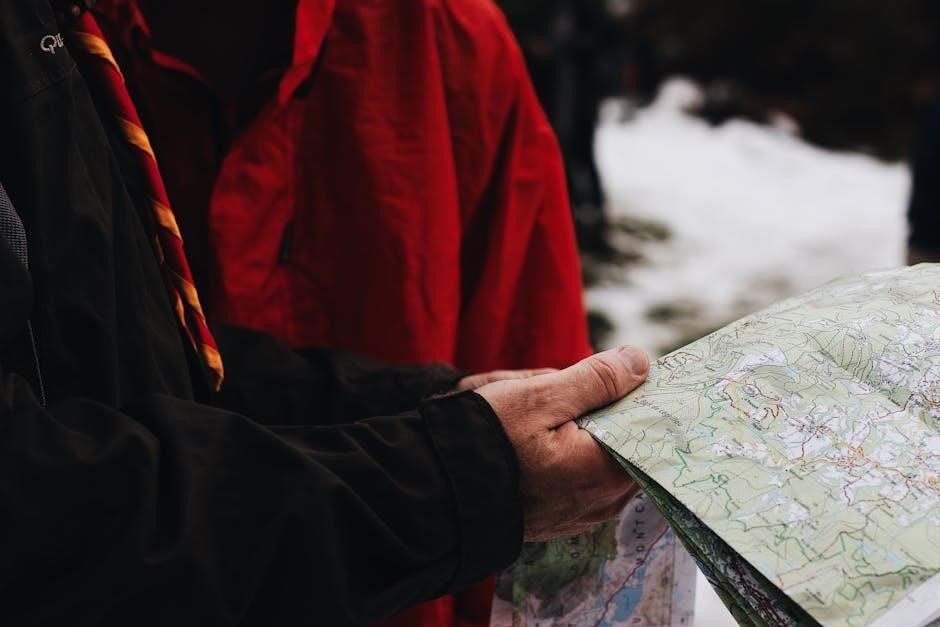
Trail Guide to the Body by Andrew Biel is a hands-on guide to locating muscles, bones, and more, trusted by therapists and students worldwide for its detailed approach and clear illustrations, making it a cornerstone in anatomy education․
Overview of the Book and Its Purpose
Trail Guide to the Body by Andrew Biel is a hands-on guide designed to help practitioners and students locate muscles, bones, and other anatomical structures with precision․ First published in 1997, this spiral-bound book is widely regarded for its practical approach, making it essential for massage therapists, physical therapists, and anatomy students․ The text emphasizes palpation techniques, providing clear, step-by-step instructions for identifying body structures․ With detailed illustrations and a user-friendly format, the book serves as both a classroom resource and a clinical tool; Its purpose is to bridge the gap between theoretical knowledge and practical application, ensuring readers can confidently apply their skills in real-world settings․ Over the years, updated editions have enhanced its value, solidifying its reputation as a foundational resource in anatomy education․
Importance of the Book in Anatomy Education
Trail Guide to the Body holds a pivotal role in anatomy education due to its unique approach to teaching musculoskeletal anatomy․ Unlike traditional textbooks, it focuses on palpation, enabling students to develop essential tactile skills․ The book’s detailed illustrations and clear instructions make complex anatomical concepts accessible․ Its spiral-bound format allows for easy reference during hands-on practice․ Widely adopted in academic and clinical settings, the guide bridges the gap between theoretical knowledge and practical application․ It is particularly valued by massage therapists, physical therapists, and occupational therapists, providing a reliable resource for accurate muscle and bone identification․ The book’s widespread use underscores its importance as a foundational tool in training future healthcare professionals, enhancing their diagnostic and therapeutic capabilities․ Its impact on anatomy education is unparalleled, making it a cornerstone in the field․
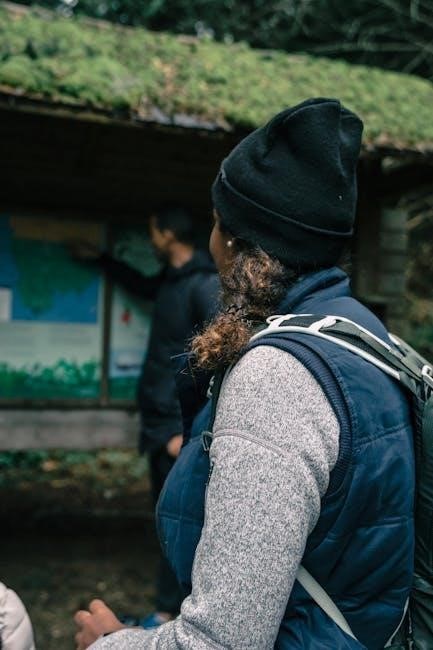
Editions and Updates
Trail Guide to the Body has undergone significant updates, with the 5th and 6th editions incorporating key features and enhancements to improve learning and practical application․
5th Edition: Key Features and Improvements
The 5th edition of Trail Guide to the Body introduced enhanced illustrations and expanded palpation techniques, providing clearer guidance for muscle and bone identification․ Spiral-bound for practical use, it included updated visuals and a more user-friendly layout․ New sections focused on functional anatomy, aiding therapists and students in understanding movement mechanics․ Additional resources, such as the Student Workbook and Flashcards, were introduced to complement the textbook, offering hands-on practice and reinforcement of key concepts․ These improvements solidified the book’s reputation as a go-to resource for anatomy education, making complex concepts accessible and applicable in real-world settings․ The 5th edition’s updates ensured it remained a trusted tool for both learners and professionals in the field of musculoskeletal anatomy․
6th Edition: New Additions and Enhancements
The 6th edition of Trail Guide to the Body builds on its predecessors with refined illustrations and additional palpation techniques, ensuring precise muscle and bone identification․ New content focuses on functional anatomy, linking musculoskeletal structures to movement patterns․ Enhanced digital resources, including interactive flashcards, complement the textbook for deeper learning․ The spiral-bound format remains, while updated visuals and expanded indexes improve navigation․ This edition also introduces cross-references to the Student Workbook, fostering integrated study․ These enhancements solidify the book’s role as a comprehensive tool for anatomy education, catering to both students and professionals seeking practical, applicable knowledge in musculoskeletal anatomy․ The 6th edition continues to set the standard for clarity and effectiveness in anatomy training․

Student Workbook and Additional Resources
The Trail Guide to the Body Student Workbook complements the textbook with exercises, while Flashcards aid in memorizing musculoskeletal anatomy, offering comprehensive tools for in-depth learning and reinforcement․
Trail Guide to the Body Student Workbook
The Trail Guide to the Body Student Workbook is designed to reinforce learning through interactive exercises, review questions, and hands-on activities․ It complements the textbook by providing practical tools to master musculoskeletal anatomy․ The workbook helps students apply their knowledge by engaging with real-world scenarios, making complex concepts more approachable․ It is an essential resource for both students and professionals, offering a structured path to proficiency in palpation and anatomical understanding․
Trail Guide to the Body Flashcards
The Trail Guide to the Body Flashcards are a companion resource to the textbook, offering a portable and efficient way to review anatomical structures․ Divided into volumes, the flashcards cover muscles, bones, and ligaments, providing clear, concise information․ They are particularly useful for self-study and exam preparation, allowing users to test their knowledge and reinforce memory․ The flashcards are designed to complement the workbook and textbook, ensuring a comprehensive learning experience․ They are an indispensable tool for students and professionals seeking to deepen their understanding of musculoskeletal anatomy in a convenient format․ This resource is widely praised for its clarity and effectiveness in aiding retention of anatomical details․
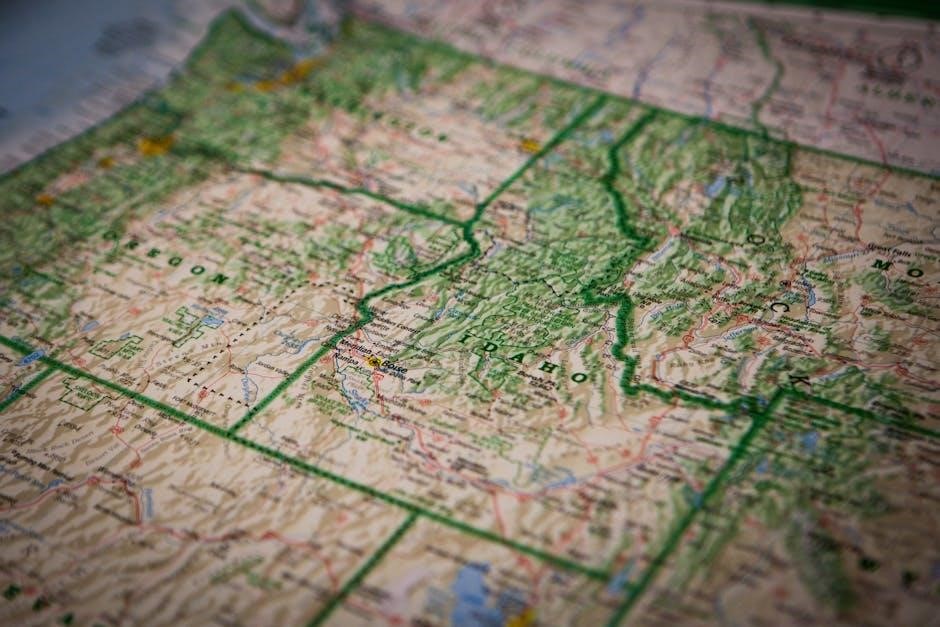
Related Books by Andrew Biel
Besides Trail Guide to the Body, Andrew Biel authored Trail Guide to Movement: Building the Body in Motion, which complements his original work by exploring anatomy through movement and motion․
Trail Guide to Movement: Building the Body in Motion
Trail Guide to Movement: Building the Body in Motion by Andrew Biel is a complementary resource to his acclaimed anatomy guide․ This book focuses on understanding human movement through detailed anatomical insights, bridging the gap between theory and practical application․ It explores how muscles, bones, and other structures interact during motion, providing a comprehensive framework for professionals and students․ The second edition includes over 900 illustrations, enhancing visual learning and making complex concepts accessible․ By integrating movement analysis with palpation techniques, Biel offers a holistic approach to understanding the body in action․ This resource is invaluable for physical therapists, massage therapists, and movement educators seeking to deepen their understanding of functional anatomy and its practical applications in real-world scenarios․
Trail Guide to the Body: How to Locate Muscles, Bones, and More
Trail Guide to the Body: How to Locate Muscles, Bones, and More by Andrew Biel is a hands-on guide designed to teach readers the art of palpation with precision and ease․ First published in 1997, this book has become a cornerstone in anatomy education, offering a user-friendly approach to understanding the human body․ It provides detailed instructions for identifying and locating muscles, bones, and other structures, making it an essential tool for therapists, students, and professionals․ The spiral-bound format allows for easy reference during practical sessions․ With its clear illustrations and step-by-step guidance, this resource empowers learners to master the fundamentals of musculoskeletal anatomy․ The 6th edition is widely regarded as the gold standard for foundational anatomy education, ensuring its continued relevance and effectiveness in both clinical and academic settings․

Content and Structure of the Book
Trail Guide to the Body offers a comprehensive exploration of musculoskeletal anatomy, palpation techniques, and detailed visual aids, structured to enhance understanding and practical application for anatomy students and professionals alike․
Musculoskeletal Anatomy: A Comprehensive Overview
Trail Guide to the Body provides an in-depth exploration of musculoskeletal anatomy, detailing the structure and function of muscles, bones, and connective tissues․ The book is renowned for its thorough coverage, offering readers a clear understanding of how these components interact․ By combining detailed descriptions with precise illustrations, it simplifies complex anatomical concepts, making them accessible to students and professionals alike․ This comprehensive overview is essential for anyone seeking to master the foundational knowledge of musculoskeletal anatomy, whether for clinical practice or academic study․ The book’s systematic approach ensures that readers can build a strong understanding of the human body’s framework and its functional mechanics․
Palpation Techniques: A Hands-On Approach
Trail Guide to the Body excels in teaching palpation techniques, offering a practical, hands-on approach to identifying muscles, bones, and other structures․ The book provides step-by-step guidance, enabling readers to develop the tactile skills necessary for accurate palpation․ Clear instructions and detailed illustrations help learners understand proper hand placement and pressure application․ This section emphasizes the importance of palpation in both clinical settings and self-study, making it an invaluable resource for massage therapists, physical therapists, and anatomy students․ By mastering these techniques, practitioners can enhance their diagnostic and therapeutic abilities, ensuring more effective treatment outcomes․ The book’s focus on palpation reinforces its reputation as a comprehensive guide for anatomy education and practical application․
Illustrations and Visual Aids in the Book
The book is renowned for its exceptional illustrations, which play a crucial role in simplifying complex anatomical concepts․ Detailed cross-sectional views and life-like drawings provide a clear visual understanding of musculoskeletal structures․ These visuals are carefully designed to complement the text, making it easier for learners to identify and locate muscles, bones, and other anatomical landmarks․ The illustrations are not only anatomically accurate but also user-friendly, catering to both beginners and experienced professionals․ By integrating visual aids, Andrew Biel ensures that readers can grasp even the most intricate details of human anatomy, making the book a cornerstone in anatomy education and practical application․
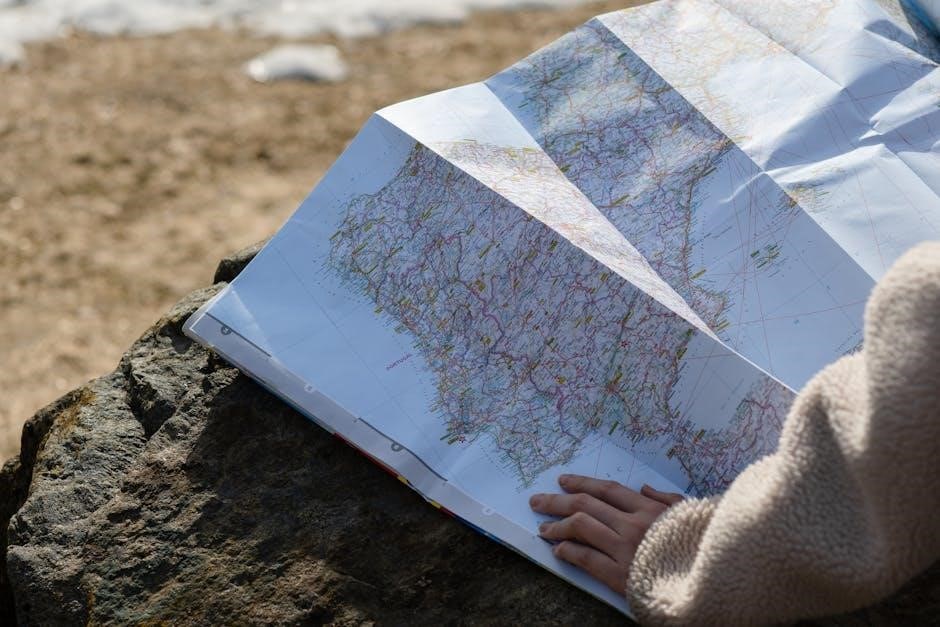
Key Features of the Book
Trail Guide to the Body features a spiral-bound format, detailed illustrations, and palpation maps, making it a top resource for anatomy education and hands-on practice․
Spiral-Bound Format: Benefits for Practical Use
The spiral-bound format of Trail Guide to the Body provides exceptional practicality, allowing the book to lie flat during use․ This feature is particularly beneficial for professionals like massage therapists and physical therapists who need easy access to information while working with clients․ The durability of the binding ensures the book remains intact even with frequent use․ Additionally, the format allows for seamless page turning, making it ideal for hands-on training and clinical settings․ This design choice enhances the book’s functionality, contributing to its reputation as a reliable and user-friendly anatomy resource․ The spiral binding is a testament to Andrew Biel’s commitment to creating a tool that complements the demands of real-world applications in anatomy education and practice․
Masterful Illustrations for Better Understanding
The Trail Guide to the Body features masterful illustrations that play a crucial role in enhancing comprehension of anatomical structures․ These visuals are meticulously detailed, providing lifelike representations of muscles, bones, and other tissues․ The illustrations are designed to complement the text, offering a clear and precise guide for identifying and palpating body structures․ Their clarity and accuracy make complex anatomical concepts more accessible, especially for students and professionals learning musculoskeletal anatomy․ The combination of detailed drawings and descriptive labels ensures that users can visualize and understand the spatial relationships between different anatomical elements․ These illustrations are a cornerstone of the book’s success, making it an indispensable resource for both educational and practical applications in anatomy education․ Their beauty and functionality contribute to the book’s reputation as a leading anatomy textbook․
Palpation Maps for Easy Muscle Location
The Trail Guide to the Body includes innovative palpation maps that simplify the process of locating muscles and other anatomical structures․ These maps are meticulously designed to guide users through the palpation process, ensuring accuracy and confidence․ By providing clear, step-by-step instructions, the maps help practitioners and students identify key landmarks and transitions between muscles․ This feature is particularly valuable for those developing their tactile skills, as it offers a systematic approach to muscle identification․ The palpation maps are complemented by detailed illustrations, reinforcing the learning process․ This tool is essential for both clinical practice and academic study, making it a standout feature of the book․ The ability to locate muscles with ease enhances the overall learning and practical application of anatomy․ This feature has been widely praised for its effectiveness in anatomy education․

Target Audience
The book is tailored for massage therapists, physical therapists, occupational therapists, and students of anatomy and physiology, making it ideal for professionals and students seeking a comprehensive understanding of musculoskeletal anatomy․
Massage Therapists and Bodyworkers
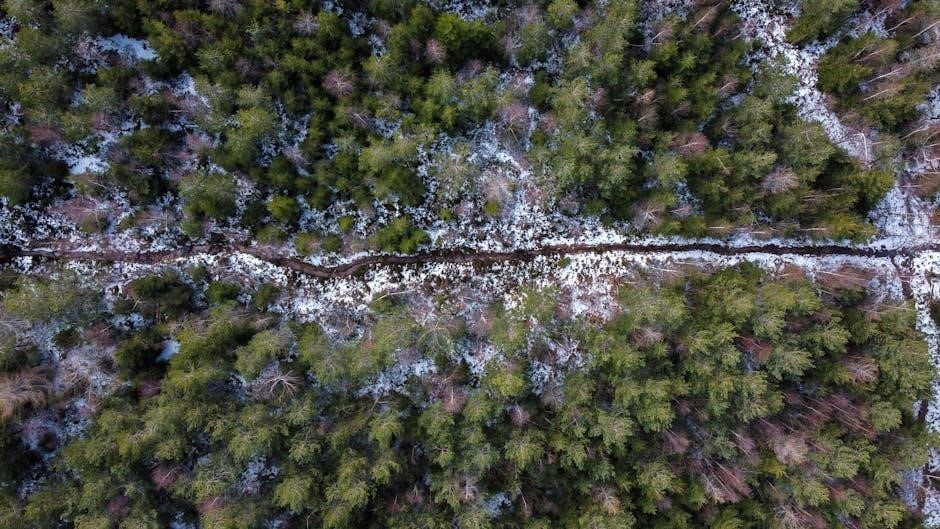
Trail Guide to the Body is an indispensable resource for massage therapists and bodyworkers, providing a comprehensive guide to palpation and musculoskeletal anatomy․ Its detailed illustrations and hands-on approach enable professionals to accurately locate and understand the body’s structures, enhancing their clinical practice․ The book’s spiral-bound format allows for easy reference during sessions, while its clear instructions ensure precise palpation techniques․ Whether for assessing muscle tension or identifying anatomical landmarks, this guide empowers therapists to deliver more effective treatments․ It is widely regarded as a foundational tool for both seasoned practitioners and those in training, offering unparalleled insights into the human body’s musculoskeletal system․
- Enhances palpation skills for precise muscle location․
- Provides clear, anatomically accurate illustrations․
- Supports effective clinical decision-making․
Physical Therapists and Occupational Therapists
Trail Guide to the Body is a vital resource for physical and occupational therapists, offering a detailed approach to musculoskeletal anatomy and palpation․ Its clear, hands-on guidance aids in precise muscle and bone identification, essential for effective treatment planning; The book’s comprehensive illustrations and spiral-bound design make it a practical tool for clinical use․ Therapists rely on its expertise to enhance patient assessment, improve intervention outcomes, and refine manual therapy techniques․ It is praised for its ability to bridge anatomical knowledge with real-world application, making it a cornerstone in rehabilitation settings․ This guide supports therapists in delivering evidence-based, patient-centered care with confidence and precision․
- Facilitates accurate anatomical identification․
- Enhances clinical assessment and treatment planning․
- Provides practical, evidence-based palpation techniques․
Students of Anatomy and Physiology
Trail Guide to the Body is an indispensable resource for students of anatomy and physiology, offering a comprehensive and accessible approach to understanding musculoskeletal anatomy․ Its detailed illustrations and hands-on guidance make complex concepts clear, allowing students to confidently locate muscles, bones, and other structures․ The book’s spiral-bound format and palpation maps are particularly useful for self-study and lab work․ It supplements academic coursework by providing practical, real-world applications of anatomical knowledge․ Students praise its ability to simplify learning, making it a go-to reference for both classroom and clinical settings․ This guide empowers students to master anatomy with precision and clarity, preparing them for successful careers in healthcare and related fields․
- Provides clear, detailed anatomical information․
- Supports hands-on learning and practical application․
- Enhances understanding of musculoskeletal structures․

Practical Applications
Trail Guide to the Body is a versatile tool for hands-on learning, enabling professionals and students to apply anatomical knowledge in clinical, educational, and self-study settings with precision and ease․
- Enhances clinical assessments and treatments․
- Supports classroom and lab instruction․
- Facilitates self-study and professional development․
Using the Book in Clinical Practice
Trail Guide to the Body is a cornerstone in clinical practice, providing precise anatomical insights that enhance assessments and treatments․ Its detailed illustrations and palpation maps guide therapists in locating muscles, bones, and other structures with accuracy, facilitating effective therapy sessions․ The book’s spiral-bound format allows for easy reference during patient consultations, making it a practical tool for massage therapists, physical therapists, and other healthcare professionals․ By enabling practitioners to quickly identify anatomical landmarks, it supports targeted and efficient care, improving patient outcomes․ Its portability and user-friendly design ensure it remains a trusted companion in daily clinical work, bridging the gap between theoretical knowledge and hands-on application․
- Enhances accuracy in anatomical assessments․
- Supports targeted and efficient treatments․
- Portable design for easy clinical reference․
Integrating the Book into Academic Curriculum
Trail Guide to the Body seamlessly integrates into anatomy and massage therapy curricula, offering a comprehensive, hands-on approach to learning musculoskeletal anatomy․ Its spiral-bound design and detailed illustrations make it ideal for classroom and lab settings, while palpation maps provide students with a practical guide for identifying anatomical structures․ Educators appreciate how the book aligns with curriculum goals, complementing lectures and lab work․ The clear, user-friendly format supports students in developing a strong foundation in anatomy, essential for future clinical practice․ By incorporating this textbook, academic programs ensure learners gain both theoretical knowledge and practical skills, preparing them for successful careers in healthcare and bodywork professions․
- Comprehensive resource for anatomy education․
- Supports hands-on learning in academic settings․
- Enhances curriculum with practical applications․
Self-Study and Professional Development
Trail Guide to the Body is an invaluable resource for self-study and professional development, offering clear, step-by-step instructions for locating anatomical structures․ Its detailed illustrations and palpation techniques enable learners to master musculoskeletal anatomy at their own pace․ Professionals, including massage therapists and physical therapists, use the guide to refine their skills and stay updated on best practices․ The accompanying workbook and flashcards further enhance self-directed learning, providing interactive tools to reinforce knowledge․ This comprehensive approach makes it an essential tool for both students and practitioners seeking to deepen their understanding of the human body and improve their clinical expertise․
- Supports independent learning with clear instructions․
- Enhances professional skills through practical exercises․
- Complemented by workbook and flashcards for self-study․

Reception and Reviews
Trail Guide to the Body is acclaimed as the gold standard in anatomy education, praised by professionals and students for its clarity, detailed illustrations, and practical approach to musculoskeletal anatomy․
Acclaimed as the Gold Standard in Anatomy Education
Trail Guide to the Body is widely recognized as the gold standard in anatomy education, trusted by professionals and students for its unmatched clarity and precision․ Since its first publication in 1997, the book has earned a reputation for its detailed, lifelike illustrations and user-friendly approach to musculoskeletal anatomy․ It is particularly praised for its emphasis on palpation techniques, making it invaluable for massage therapists, physical therapists, and anatomy students․ The book’s spiral-bound format and palpation maps enhance its practicality, allowing users to easily locate muscles and bones during practice․ Its comprehensive coverage of the human body has made it a cornerstone in both clinical and academic settings, solidifying its status as a leading resource in anatomy education․
Feedback from Professionals and Students
Trail Guide to the Body has received widespread acclaim from professionals and students alike for its practical approach to anatomy education․ Many praise its detailed, lifelike illustrations and user-friendly format, which make complex anatomical concepts accessible․ Professionals, including massage therapists and physical therapists, appreciate the book’s focus on palpation techniques, noting how it enhances their ability to locate muscles and bones accurately․ Students highlight the book’s clarity and spiral-bound design, which allows for easy reference during study and practice․ The combination of comprehensive content and hands-on guidance has made it a favorite in both academic and clinical settings, with many considering it indispensable for mastering musculoskeletal anatomy․ Its reputation as a go-to resource continues to grow, solidifying its place in anatomy education․
Comparisons with Other Anatomy Textbooks
Trail Guide to the Body is often compared to other anatomy textbooks but stands out for its practical, hands-on approach․ While many anatomy books focus on detailed theoretical knowledge, Biel’s work emphasizes palpation and real-world application, making it a favorite among massage therapists and physical therapists․ Its spiral-bound format and clear illustrations enhance usability, setting it apart from more traditional textbooks․ Unlike some competitors, it avoids overwhelming readers with excessive detail, instead offering a focused, accessible guide to musculoskeletal anatomy․ Professionals and students alike appreciate its tailored approach to their needs, distinguishing it as a top choice for those seeking a balance between academic rigor and practical utility․ This makes Trail Guide to the Body a unique and indispensable resource in the field of anatomy education․
Trail Guide to the Body remains a cornerstone in anatomy education, offering unparalleled practical insights and setting a new standard for hands-on learning in musculoskeletal anatomy․
The Significance of “Trail Guide to the Body” in Modern Anatomy Education
Trail Guide to the Body is widely regarded as the gold standard in anatomy education, revolutionizing how students and professionals learn musculoskeletal anatomy․ Its unique approach combines detailed illustrations with hands-on palpation techniques, making complex anatomical structures accessible․ The book’s spiral-bound format and user-friendly design cater to both classroom and clinical settings, fostering a deeper understanding of the human body․ By emphasizing practical application, it bridges the gap between theoretical knowledge and real-world practice, making it indispensable for massage therapists, physical therapists, and anatomy students․ Its impact is evident in its widespread adoption across educational institutions and clinical practices, solidifying its role as a foundational resource in modern anatomy education․
Future of Anatomy Education and the Role of Andrew Biel’s Work
Andrew Biel’s work, particularly Trail Guide to the Body, is shaping the future of anatomy education by integrating hands-on learning with visual and tactile approaches․ His books emphasize practical application, ensuring students and professionals can apply anatomical knowledge effectively in clinical settings․ The use of detailed illustrations and palpation maps creates a comprehensive learning experience, making complex concepts accessible․ As anatomy education evolves, Biel’s resources remain central, bridging the gap between theory and practice․ His contributions continue to influence the development of anatomy textbooks, ensuring future generations of therapists and medical professionals are well-equipped with the knowledge and skills needed for effective patient care and treatment․